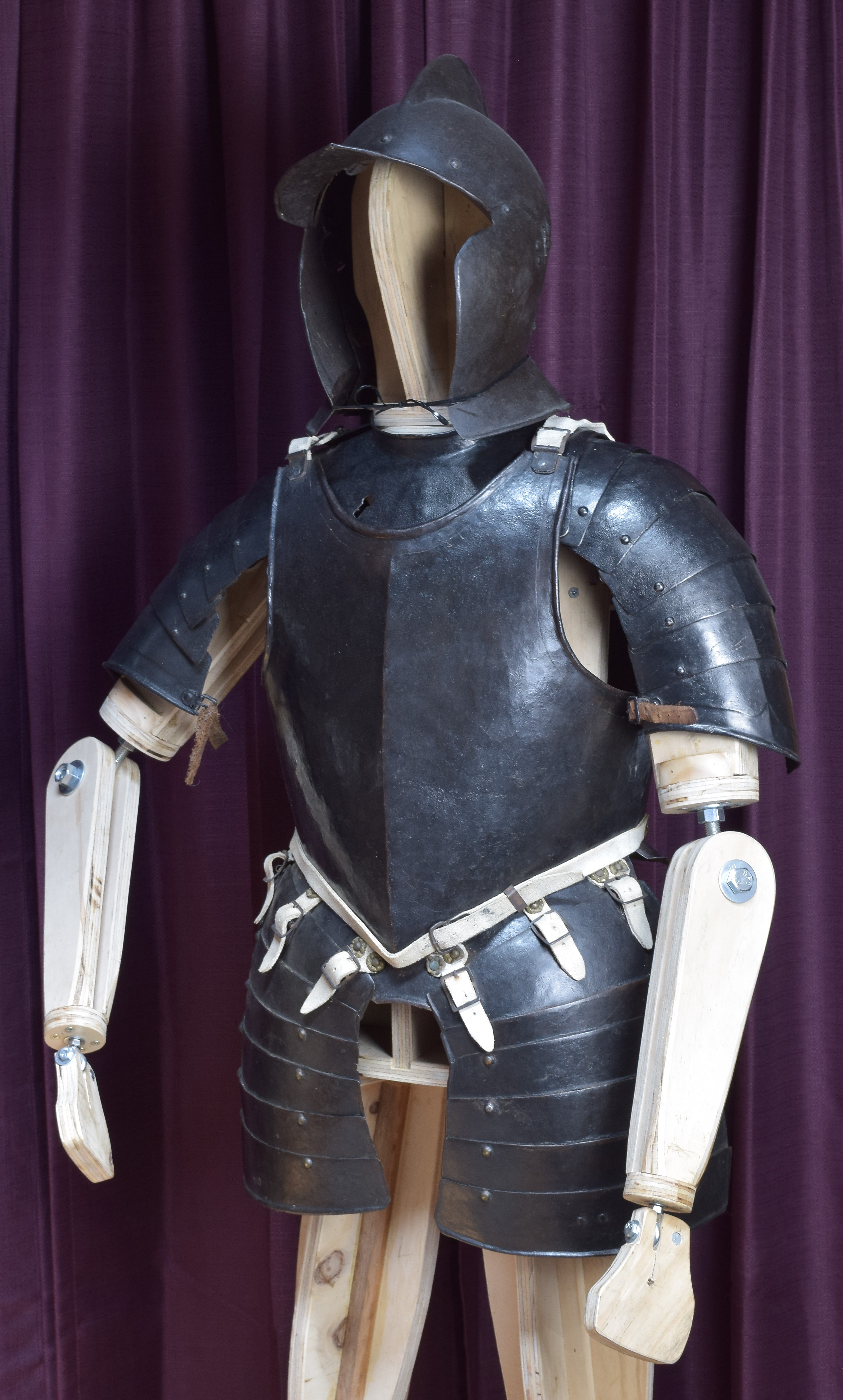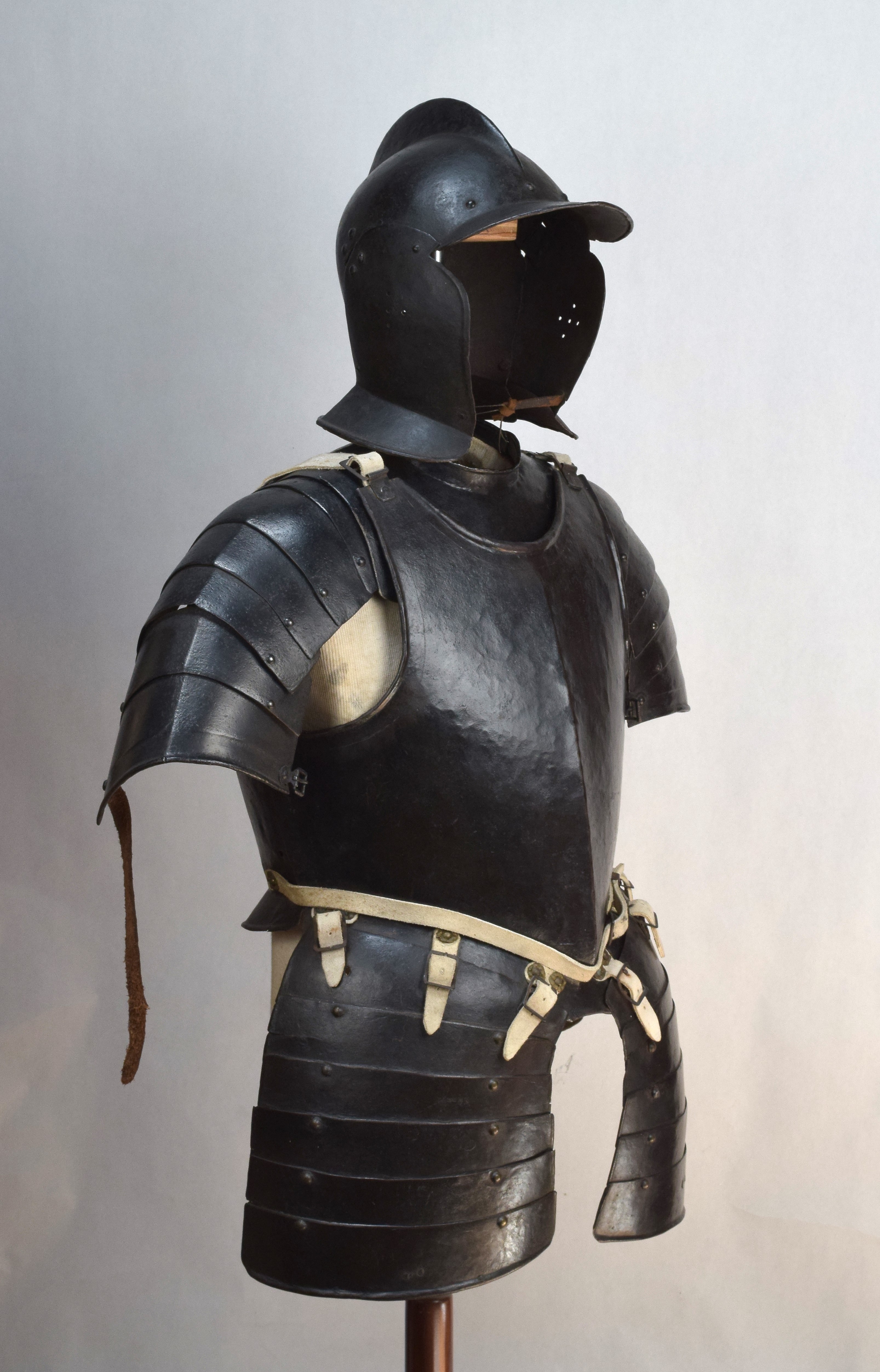














Half Suit 1580-1600
Very typical munition form. Consisting of a breast, back, tassets and almain collar. Shoulder straps, belt and tasset straps expertly replaced with good simulation of buff leather. Breast, back and tassets very well matched. Possibly originally forming parts of the same armor. Purchased item number A-348 without a helmet. It has been completed using item number A-285 in these pictures. It has also been displayed with item number A-273. The wooden stand illustrated in the display was built from Sean Powell's plans for the stands made for the Worcester Art Museum.
Burgonet: Augsburg. One piece skull with high angled comb and integral peak. Single neck lame and a pair of cheek plates. Rough from the hammer. Point of the peak with two marks, one the Augsburg pinecone, the other indistinct. The edge of the peak formed with a simple inward turned roll coming to a blunt point at the center and with a central crease. Neck plate with plain inward turn at the outer edge coming to a blunt point and with a pair of holes near the point for suspension in an arsenal. Cheek plates with a simple bump at the face, inward turned roll at the bottom and pierced with five holes over the ear. Retains lining rivets at the neck and forhead which still secure remains of the leathers. Signs of delamination esp. in the roll on the peak, some corrosion above the right cheek plate and the left hinge cracked. Nice shape with original parts.
Weight: 3 pounds 6.8 ounces (1550 g).Measurements: skull app. .045 varying mostly .035-.053, Cheek plates mostly .045 (generally thicker near the bottom above the flare and the flare thinning as it gets toward the roll), neck lame generally thicker at the top and thinning toward the roll, mostly .05 down to .03.
Breastplate: Good simple peascod form with integral flare forming a fauld. Inward turned plain rolls at the neck, arm holes and center of the flare between the tassets. Single engraved line at the neck and arm holes parallel to the rolls. Buckles at the shoulder (replaced). Fauld flare carries three straps on each side for the attachment of the tassets. Black rough from the hammer finish (refreshed with paint). Leathers replaced. Marked internally '14' matching the back and tassets.
Backplate: Simple back formed to the body with a narrow flare at the waist. Plain inward turns at the arms, neck and base of the flare. Single engraved lines at the neck and arm holes. Modern straps simulating buff at the shoulders and waist to secure the breastplate. Black rough from the hammer finish. Marked internally '14' matching the breast and tassets.
Pair of Tassets: Consisting of six horizontal plates. Plates secured by rivets front and back and a (lost) central internal leather. Lower edge with a plain inward turned roll. Sides with simple bump simulating a roll. Top plates with three buckles (replaced) for suspension from the breastplate. Black rough from the hammer finish (refreshed with paint). Marked internally '14' matching the back and breast.
Almain collar: Very typical munition form. Consisting of a gorget plate front and back with shoulders on each side of 6 plates. Main plates with raised integral collar. Plain inward turned roll at the neck. Shoulders of 6 plates each, the lower one with a roped inward turn at the elbow and recessed border rising to a central cusp. The shoulders have the typical form - a narrow top plate, a larger more shaped shoulder plate, three relatively straight plates and a terminal plate formed to the elbow. Terminal plates with buckles at the front and straps at the back to secure the armor around the arm. Black rough from the hammer finish (refreshed with paint).
This is an interesting example of 'restoration.' One shoulder appears to be late 16th c. The bottom two plates of the other shoulder match. The upper plates of that shoulder are reasonably well made modern plates. The central gorget plates are less well made simulating a very low end 17th c. piece. All of this doesn't look bad when displayed as part of a half suit, but it isn't right and shouldn't be used as example. The overall matching modern paint helps to blend the disparate pieces together.
I have provided interior images to help to show what is going on here. The first detailed image shows the inside of the right shoulder. Here we see the expected hammer marks, signs of oxidation and flaking of old finish and a more modern paint overall. The washers and rivets at the back are consistent - until we get to the final one that connects to the gorget. Here the washer is smaller and just has a different look. We also see that there is another hole next to the top of the slot. The leathers look good, but there are newer pieces patched into the end. All of this tells us that the shoulder is probably good, but it has been attached to the gorget recently. The unfilled hole at the top back is because the typical way to secure a shoulder to the gorget in an almain collar is with a small leather. These are often replaced by rivets later because it is easy, or it seems to make sense. At this point we have a good feel for the shoulder, but know that something has happened with the gorget. Since this is the spot that tends to tear out first, this might just be a repair.
The next image shows the inside of the left shoulder. Here we see a big difference between the condition of the two terminal plates and the other four. This tells us to look more closely. Next we see that the leathers are different from the ones we see in the other shoulder. These feel more modern, the rivets are definitely more modern and they have not torn out between the shoulder and the gorget, so they are probably recent work. Looking at the four upper plates, they mostly have good shape but there aren't any signs of overall hammering or damage from age. We also see that there isn't any sign of a second hole at the back of the top plate and the upper edge of the top plate is slightly flared. All of this indicates that the upper four plates are modern. If the only thing that lept out at us were modern leathers, that would be fine. But there is a lot more here.
Next we see the inside of the back plate of the gorget. There are hammer marks, but they don't cover the surface and they appear (mostly) to have been done onto a soft surface (the round dents) or onto or over an edge (long straight lines). There is also no sign of oxidation. This looks like a piece of modern rolled steel that has been minimally hammered into shape. The inside of old armor just doesn't look like this.
Finally we see the buckles. The one on the right (old and complete) shoulder looks like an original buckle. The one on the left is not bad. It is mounted on a well made plate, but it is a modern buckle (which appears to be placed backwards).
Playing around with the piece on a stand and comparing it to other collars I can also see that the main gorget plates are not wide enough to work correctly. The size doesn't allow the second lame of the shoulder to sit at the point of the shoulder as it should. So you end up with the shoulders bending farther down and not sitting right.
If you have any questions, please send them to Wade Allen
This site last updated Sat Apr 27 13:09:09 EDT 2024